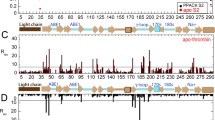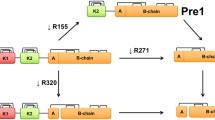Abstract
High molecular weight kininogen is a cofactor of the surface-dependent phase of the blood-clotting cascade. Unique sequence-binding sites are exposed on the surface of this glycoprotein which complex prekallikrein or factor XI with high affinity and specificity (Tait and Fujikawa, 1987). A sequence comprising 31-residues (residues 565–595 of the mature kininogen molecule) retains full binding activity for prekallikrein but the sequence 569–595 (27 residues) shows only 25% of this binding affinity (Vogelet al., 1990). Thus, the key structural features required for protein recognition reside in the 31-residue sequence but these features are likely compromised (or absent) in the 27-residue sequence. To determine the conformation of the prekallikrein-binding domain, peptides comprising the 31- and 27-residue sequences were prepared by solid-phase methods and their structures determined by circular dichroism, fluorescence polarization, and 2D-NMR techniques. Fluorescence emission spectra, polarization, and anisotropy measurements of the single Trp residue present in both peptides show that the 31-residue peptide contains an ordered microenvironment at its amino terminus, which is not present in the 27-residue peptide. This structural ordering is characterized by movement of the Trp residue into a more polar environment. Further, the 31-residue peptide possesses a higher limit anisotropy, longer rotational relaxation time, and shows a higher polarization value even at elevated temperatures. Circular dichroic spectra of both peptides in the far UV region are essentially identical and indicate that both peptides contain predominantly β-turn elements, but also contain some α-helix, β-sheet, and random coil character. The structural elements of both peptides are unchanged in urea solution, but the negative ellipticity absorption band in the near UV region assignable to Trp is eliminated in acid solution upon protonation of the neighboring -Asp-Asp-Asp- triplet. In the two peptides, the spin system of each amino acid has been assigned through 2D-1H scalar coupling correlated experiments; pure absorption NOESY experiments were used to determine through-space connectivities. The results are entirely consistent with the previous experiments in that both peptides contain predominantly β-turn elements and the amino terminus of the 31-residue peptide is highly ordered in comparison with the 27-mer; in fact, this region is likely to be helical in nature. In addition to the turn and sheet elements, the 31-mer shows long-range connectivities which are not present in the 27-mer. Hence, the 31-mer likely folds in solution forming a unique domain. By inference, the N-terminal segment of the 31-residue peptide contributes in large part to its fourfold increase in affinity for prekallikrein.
Similar content being viewed by others
References
Bock, P. E., Shore, J. D., Tans, G., and Griffen, J. H. (1985).J. Biol. Chem. 260, 12,434–12,443.
Bouma, B. N., Vlooswijk, R. A. A., and Griffen, J. H. (1983).Blood 62, 1123–1131.
Cantor, C. R., and Schimmel, P. R. (1980). InBiophysical Chemistry: Techniques for the Study of Biological Structure and Function. Part II, W. H. Freeman, San Francisco, pp. 454–455.
Chang, C. T., Wu, C. C., and Yang, J. T. (1978).Anal. Biochem. 91, 13–31.
Kellerman, J., Lottspeich, F., Henschen, A., and Müller-Esterl, W. (1986).Eur. J. Biochem. 154, 471–478.
Mandle, R. J., Colman, R. W., and Kaplan, A. (1976).Proc. Natl. Acad. Sci. USA 73, 4179–4183.
Marion, D., and Wüthrich, K. (1983).Biochem. Biophys. Res. Comm. 113, 967–973.
Müller-Esterl, W., Iwanaga, S., and Nakanishi, S. (1986).Trends Biochem. Sci. 11, 336–339.
Rance, M., Sorenson, O. W., Bodenhausen, G., Wagner, G., Ernst, R. R., and Wüthrich, K. (1983).Biochem. Biophys. Res. Comm. 117, 479–485.
Tait, J. F., and Fujikawa, K. (1986).J. Biol. Chem. 261, 15,396–15,401.
Tait, J. F., and Fujikawa, K. (1987).J. Biol. Chem. 262, 11,651–11,656.
Thompson, R. E., Bouma, B. N., Cochrane, C. G., and Griffen, J. H. (1977).J. Clin. Invest. 60, 1376–1380.
Thompson, R. E., Mandle, R., and Kaplan, A. P. (1979).Proc. Natl. Acad. Sci. USA 76, 4862–4866.
Vogel, R., Kaufmann, J., Chung, D. W., Kellermann, J., and Müller-Esterl, W. (1990).J. Biol. Chem. 265, 12494–12502.
Weber, G. (1952).Biochem. J. 51, 145–155.
Wüthrich, K. (1986).NMR of Proteins and Nucleic Acids, John Wiley & Sons, New York, pp. 1–286.
Author information
Authors and Affiliations
Rights and permissions
About this article
Cite this article
Scarsdale, J.N., Harris, R.B. Solution phase conformation studies of the prekallikrein binding domain of high molecular weight kininogen. J Protein Chem 9, 647–659 (1990). https://doi.org/10.1007/BF01025019
Received:
Published:
Issue Date:
DOI: https://doi.org/10.1007/BF01025019




